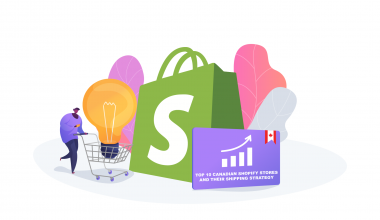Canadian D2C brands work in a challenging environment due to the geography of the region. The complications created as a result of that, such as high shipping costs, long delivery times, and rising customer expectations, always put a question on how viable carriers are. Even brands that have already been established have to tackle issues like winter delays, cross-border compliance, geographical constraints, and high rural surcharges, all of which cause fulfillment to slow down.
To deal with such a quagmire of problems, shipping software has become a key tool to have. It centralizes everything, makes label generation easier, automates tasks, and predicts delivery times while keeping errors low.
Brands that invest in this product get access to multiple perks, including comparing carrier rates, calculating duties before delivery, and integrating orders from more than one carrier. This leads to streamlined delivery and a happy customer.
What to Look for in Shipping Software as a Canadian D2C Brand?
To get the business going the right way means finding the right shipping software. The requirements may vary, but there are common aspects to look out when selecting a system that works for a brand.
Local carrier integrations
Canadian D2C brands must heavily on domestic carriers. And thanks to a robust integration that a proper shipping software provides, users can get access to negotiated rates, label printing, and real-time delivery estimates. Direct support for Canada Post, Purolator, and Canpar allows brands to switch between carriers based on price, speed, or service reliability without manual comparison.
Cross-border capabilities
Cross-border sales are the main revenue generations for Canadian brands. Shipping software that have access to strong US-Canada capabilities can automatically deal with customs forms, calculate duties and taxes, and provide accurate delivery estimates for American customers. This reduces delays at the border and increases conversion rates for US shoppers.
Real-time tracking and branded updates
Customers want to keep an eye on where their product is growing, which means having access to transparent tracking across every step of the journey. Platforms that offer real-time updates and branded tracking pages help reduce “Where is my order?” queries and reinforce trust. Unified tracking across multiple carriers also simplifies internal operations.
Return management
Customer want easy returns to be accessible to them, which is the reason behind efficient return workflows causing better customer retention. Platforms that are able to automate the process, that is, automatically generate return labels, offer self-serve return portals, and sync status updates back to the store help brands control costs while keeping the experience smooth for shoppers.
Easy integration with Shopify, WooCommerce, etc.
Most Canadian D2C brands operate on Shopify or WooCommerce. Shipping software that offer seamless plug-and-play integration with them ensures automatic order syncing, faster fulfilment, and fewer errors, making the entire logistics stack easier to manage at scale.
The Top 3 Shipping Software Platforms for Canadian D2C Brands
Many shipping software platforms exist for Canadian D2C brands to pick. They all have their perks and shortfalls. However, for those looking for best all worlds, the following options are suitable.
1. ShipStation
ShipStation is a shipping platforms with users globally and is known for it support for Canadian sellers thanks to its full carrier integrations. This has resulted in it becoming a strong choice for brands shipping within Canada and beyond. For instance, ShipStation Canada lists carriers such as Canada Post, Purolator Inc., UPS, DHL and FedEx.
Central to its ecosystem is its focus on a clean UI and dashboard are built for small-to-midsize stores, offering batch label printing, branded tracking pages and automated shipping rules, which leads to fewer manual tasks.
On the other hand, however, as shipping volume or feature usage grows (e.g., advanced automation, international carrier tiers), pricing tiers can get expensive. This means that it is a robust platform that mid-sized brands should consider, but without being blind to monitor recurring costs to ensure the feature set aligns with their volume and margin expectations.
2. Easyship
Easyship is a platform that was reportedly designed with cross-border D2C in mind, which makes it an excellent choice for Canadian brands expanding into the U.S. or other international markets. One of its core features is built-in duties & taxes calculation, which merchants can leverage to estimate import duties and taxes automatically so that destination customers aren’t surprised.
The platform also supports 220+ destinations and offers visibility when it comes to core price breakdown, helping Canadian brands to price correctly and avoid shipping surprises.
For brands with eyes on scaling internationally, this brand shines, as it offers transparent checkout costs, including duties, and shipping solutions for U.S./Canada & beyond. However, the value of this tool should not let customers ignore the root trade-off, which comes in the form of complexity. It means that unlike simpler domestic-only tools, the full set of cross-border tools that Easyship offers may require more setup and integrate with international fulfilment partners. Also, domestic Canadian-only shipping use may not fully exploit its feature set.
3. Shippo
Shippo is an API-first shipping software platform that caters well to brands with technical resources and a need for carrier rate visibility and developer-friendly workflows. It supports 40+ global carriers and offers access to discounted rates via the Canadian-carrier partner network. For instance, through Canada Post via the master-account deal.
Flexibility is its attractive attribute, which makes it highly suitable for brands with tech-savvy teams who can integrate it deeply into the back-end of their own systems. This leads to more customize workflows, and access to features like real-time rate comparison across carriers. For Canadian brands that want fine-grained control and best-in-class carrier rate visibility, Shippo is compelling.
The only drawback is that it is not a standard plug-and-play system, which means brands with teams that don’t have technical background may face higher costs when it comes to set up or maintenance.
Core recommendations:
- Brands focusing on domestic shipping but want to scale their businesses should focus on ShipStation
- Brands looking to expand across the border and want full access to access duties and tax information should consider Easyship
- Brands with highly capable tech teams and eye for deep carrier control could benefit from picking Shippo
Feature Comparison Table: Which Tool Fits Your Brand?
Given below is the complete table offering succinct details into the shipping software platforms discussed above. It will make it further easy for brands to take their pick.
| Software | Best For | Integrations | Price Range* | Canadian Carrier Support |
| ShipStation | Small-to-midsize stores needing ease and scale | Shopify, WooCommerce, Amazon, eBay, marketplaces | From ~US$20/month, scales with volume | Canada Post, Purolator, UPS, FedEx, DHL |
| Easyship | Brands expanding cross-border (US/international) | Shopify, WooCommerce, BigCommerce, major carts | Free plan; paid plans from ~US$29/month | Supports Canada-origin shipments, duties & taxes automation |
| Shippo | Tech-savvy teams needing API flexibility | Shopify, WooCommerce, API/custom workflows | Free plan; paid plans from ~US$17/month | Canada Post, UPS Canada, other major carriers |
Key Integrations: What to Look for When Choosing Software
Given below are the key integrations, an essential checklist, to look at when selecting a shipping software platform:
Ecommerce platform integrations
Ensure the software connects seamlessly with Shopify, WooCommerce, or your specific cart so orders and fulfilment data sync automatically.
Canadian carrier integrations
Look for direct support for Canada Post, Purolator, Canpar, UPS Canada, and other local carriers to maintain accurate rates and reliable delivery options.
Cross-border shipping integrations
If selling into the US or internationally, choose tools that automate customs forms, duties, and taxes to reduce border delays.
Accounting and ERP connections
Integrations with tools like QuickBooks or inventory systems help maintain clean operations and reduce manual reconciliation.
Branded tracking and notifications
Platforms with tracking-page and email/SMS integrations enhance the post-purchase experience and lower customer-support volumes.
Common Mistakes to Avoid When Picking Shipping Software
Here are key mistakes Canadian D2C brands should steer clear of:
Ignoring integration with sales platforms
Integrations with sales platforms should not be ignored because the facilities of integrations are many.
For example, how Shippo pulled data from Square into Kelm Form Tools’ workflow meant the founder didn’t have to flip between apps when packing. Initially, the company was only focusing on transacting for cash or eTransfers on Canada Post. However, the company later integrated Shippo and Square, which helped with accessibility. Furthermore, the integration has helped the company from $5 to $7 per order.
Choosing software solely on upfront cost
A low-monthly fee may hide expensive per-shipment surcharges or costly add-ons later.
Skipping return-management features
Neglecting returns workflows can erode customer loyalty and increase support burden.
Overlooking rural surcharges and Canadian shipping contingencies
Canadian geography makes delivery cost dynamics quite different from the U.S.; assume a Canadian-specific check.
Avoiding these will help ensure your shipping tool supports growth rather than becoming a bottleneck.
FAQs
How can Canadian D2C brands reduce shipping costs without compromising delivery speed?
Canadian D2C brands can lower shipping costs by using software that compares rates across Canada Post, Purolator, UPS Canada, and regional carriers. These platforms allow businesses to select the most cost-efficient option for each order based on weight, zone, and delivery timeline.
Many tools also allow the creation of automation rules, where the software selects the cheapest suitable carrier without manual effort. Brands can further reduce expenses by enabling address verification, which lowers return-to-sender fees, and by negotiating carrier discounts once shipping volume increases. Using fulfilment centers near customer clusters can also reduce long zone jumps that are common in Canada.
Which carriers integrate best with Canadian shipping software?
The strongest integrations typically involve Canada Post, Purolator, Canpar, UPS Canada, FedEx, and DHL. Shipping platforms designed with Canadian users in mind provide real time rate visibility, label printing, and automated tracking events for these carriers. Canada Post remains the most essential domestic carrier due to reach and rural delivery coverage, while Purolator and UPS Canada support faster urban deliveries. The best shipping software ensures that carriers can be switched easily based on delivery time, surcharge avoidance, and customer expectations.
What tracking features should a Canadian D2C brand expect from modern shipping software?
Tracking features should provide real time updates across every carrier used by the brand. Unified tracking ensures that both the business and the customer can see the status of the shipment in a single view. Branded tracking pages make the post purchase experience more professional and help reduce the volume of queries. These tools should also include proactive notifications through email or SMS to reassure customers during winter delays, border checks, and rural deliveries. A good tracking page reduces the number of support tickets and boosts customer trust.
How can shipping software help businesses manage returns in Canada?
Canadian shoppers expect simple return processes, especially for apparel, footwear, and subscription goods. Shipping software with built-in return management can generate a return label automatically, sync return status with the ecommerce store, and reduce staff involvement for routine cases.
Self serve return portals give customers the freedom to initiate returns any time, which improves their confidence in the brand. Since return shipping from rural or remote regions can be expensive, software tools help optimize the process by selecting the best carrier based on location and cost.
Which shipping software is best for small or growing Canadian D2C stores?
ShipStation is often the top pick for small to midsize Canadian brands because it balances usability, automation options, and strong domestic carrier support. Easyship is ideal for brands that earn substantial revenue from US customers.
Shippo works well for brands that have technical teams who want deeper control over rate display and carrier logic. The right choice depends on product weight, average order volume, and cross border needs.
- Best Shipping Software for Canadian D2C Brands - November 25, 2025
- Why Affordable Express Shipping Feels Impossible During the Holidays? - November 19, 2025
- Why Holiday Shipping Can Make or Break Canadian Electronics Brands? - November 13, 2025






